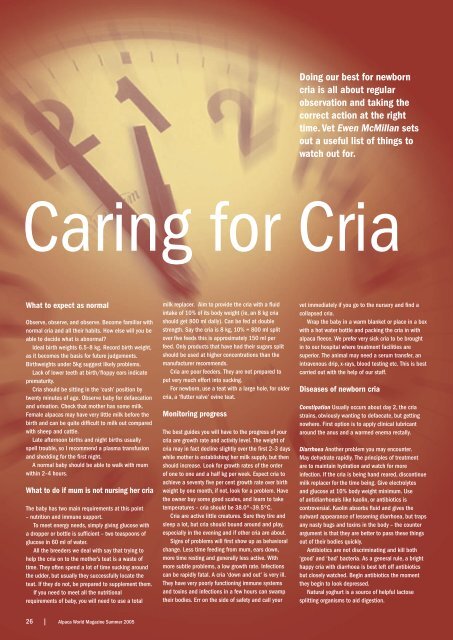Alpaca World Magazine Summer 2005 - Classical MileEnd Alpacas
Alpaca World Magazine Summer 2005 - Classical MileEnd Alpacas
Alpaca World Magazine Summer 2005 - Classical MileEnd Alpacas
- No tags were found...
Create successful ePaper yourself
Turn your PDF publications into a flip-book with our unique Google optimized e-Paper software.
Doing our best for newborncria is all about regularobservation and taking thecorrect action at the righttime. Vet Ewen McMillan setsout a useful list of things towatch out for.Caring for CriaWhat to expect as normalObserve, observe, and observe. Become familiar withnormal cria and all their habits. How else will you beable to decide what is abnormal?Ideal birth weights 6.5–8 kg. Record birth weight,as it becomes the basis for future judgements.Birthweights under 5kg suggest likely problems.Lack of lower teeth at birth/fl oppy ears indicateprematurity.Cria should be sitting in the ‘cush’ position bytwenty minutes of age. Observe baby for defaecationand urination. Check that mother has some milk.Female alpacas may have very little milk before thebirth and can be quite diffi cult to milk out comparedwith sheep and cattle.Late afternoon births and night births usuallyspell trouble, so I recommend a plasma transfusionand shedding for the fi rst night.A normal baby should be able to walk with mumwithin 2–4 hours.What to do if mum is not nursing her criaThe baby has two main requirements at this point– nutrition and immune support.To meet energy needs, simply giving glucose witha dropper or bottle is suffi cient – two teaspoons ofglucose in 60 ml of water.All the breeders we deal with say that trying tohelp the cria on to the mother’s teat is a waste oftime. They often spend a lot of time sucking aroundthe udder, but usually they successfully locate theteat. If they do not, be prepared to supplement them.If you need to meet all the nutritionalrequirements of baby, you will need to use a totalmilk replacer. Aim to provide the cria with a fl uidintake of 10% of its body weight (ie, an 8 kg criashould get 800 ml daily). Can be fed at doublestrength. Say the cria is 8 kg, 10% = 800 ml splitover fi ve feeds this is approximately 150 ml perfeed. Only products that have had their sugars splitshould be used at higher concentrations than themanufacturer recommends.Cria are poor feeders. They are not prepared toput very much effort into sucking.For newborn, use a teat with a large hole, for oldercria, a ‘fl utter valve’ ovine teat.Monitoring progressThe best guides you will have to the progress of yourcria are growth rate and activity level. The weight ofcria may in fact decline slightly over the fi rst 2–3 dayswhile mother is establishing her milk supply, but thenshould increase. Look for growth rates of the orderof one to one and a half kg per week. Expect cria toachieve a seventy fi ve per cent growth rate over birthweight by one month, if not, look for a problem. Havethe owner buy some good scales, and learn to taketemperatures – cria should be 38.0º–39.5ºC.Cria are active little creatures. Sure they tire andsleep a lot, but cria should bound around and play,especially in the evening and if other cria are about.Signs of problems will fi rst show up as behavioralchange. Less time feeding from mum, ears down,more time resting and generally less active. Withmore subtle problems, a low growth rate. Infectionscan be rapidly fatal. A cria ‘down and out’ is very ill.They have very poorly functioning immune systemsand toxins and infections in a few hours can swamptheir bodies. Err on the side of safety and call yourvet immediately if you go to the nursery and fi nd acollapsed cria.Wrap the baby in a warm blanket or place in a boxwith a hot water bottle and packing the cria in withalpaca fl eece. We prefer very sick cria to be broughtin to our hospital where treatment facilities aresuperior. The animal may need a serum transfer, anintravenous drip, x-rays, blood testing etc. This is bestcarried out with the help of our staff.Diseases of newborn criaConstipation Usually occurs about day 2, the criastrains, obviously wanting to defaecate, but gettingnowhere. First option is to apply clinical lubricantaround the anus and a warmed enema rectally.Diarrhoea Another problem you may encounter.May dehydrate rapidly. The principles of treatmentare to maintain hydration and watch for moreinfection. If the cria is being hand reared, discontinuemilk replacer for the time being. Give electrolytesand glucose at 10% body weight minimum. Useof antidiarrhoeals like kaolin, or antibiotics iscontroversial. Kaolin absorbs fl uid and gives theoutward appearance of lessening diarrhoea, but trapsany nasty bugs and toxins in the body – the counterargument is that they are better to pass these thingsout of their bodies quickly.Antibiotics are not discriminating and kill both‘good’ and ‘bad’ bacteria. As a general rule, a brighthappy cria with diarrhoea is best left off antibioticsbut closely watched. Begin antibiotics the momentthey begin to look depressed.Natural yoghurt is a source of helpful lactosesplitting organisms to aid digestion.26 | <strong>Alpaca</strong> <strong>World</strong> <strong>Magazine</strong> <strong>Summer</strong> <strong>2005</strong>







